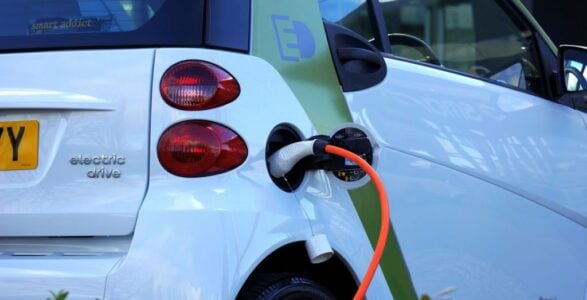Guide to PHEVs: Plug-In Hybrid Electric Vehicles

Updated 5 November 2024 | Published 22 June 2022
What is a plug-in hybrid ?
A plug-in hybrid, or plug-in hybrid electric vehicle (PHEV), is a type of hybrid car that combines the best of both electric and traditional fuel vehicles. With both a rechargeable battery and an internal combustion engine, a PHEV offers flexibility by running on electric power when available and switching to petrol or diesel when needed. This “bridge” technology provides an eco-friendly alternative without the range limitations of full battery electric vehicles (BEVs).
How Does a Plug-in Hybrid Work?
A PHEV can be plugged into a standard electric outlet to charge its battery, unlike regular hybrids, which rely solely on regenerative braking and the engine to recharge. The car runs on electric power until the battery is depleted, then switches to the petrol or diesel engine. This means a PHEV can often handle short daily drives with zero emissions while maintaining the flexibility of traditional fuel for longer trips.
From powering the wheels to running in-car electronics, PHEVs use both electric and combustion power as needed, delivering a smooth and energy-efficient driving experience.
Charging a PHEV: What You Need to Know
Charging a PHEV is similar to charging a fully electric vehicle but with quicker charging times thanks to smaller batteries. Here’s a simple guide:
- Home Charging: Most PHEVs come with a charging cable that can be plugged into a standard household outlet. For faster charging, a home charge point is recommended, cutting recharge times by half.
- Public Charging: Rapid chargers are now widely available across the UK and can charge PHEVs faster than home outlets, making them ideal for quick top-ups while out and about. This expanded network makes PHEVs more convenient for drivers who need a rapid boost.
- Charging Cost & Speed: Costs and speeds vary by model. A typical PHEV recharges in 1.5-3 hours on a 240V outlet, and you can reduce home charging costs by using off-peak electricity tariffs.
PHEVs vs. Mild Hybrids: What’s the Difference?
While both mild hybrids and PHEVs have an electric motor and combustion engine, they function differently:
- Mild Hybrids: The electric motor supports the combustion engine during acceleration or when cruising but cannot run the car independently.
- Plug-in Hybrids: PHEVs allow you to drive in electric-only mode for short distances. However, to make the most of this mode, you need to recharge regularly.
With access to a growing number of rapid chargers throughout the UK, PHEVs offer a middle ground for drivers who want to lower emissions and fuel costs without fully committing to electric-only power.
What is the Range of a PHEV?
PHEVs typically offer two types of range:
- Battery Range: Most PHEVs deliver around 30-50 miles on electric power alone, though newer models may reach up to 60 miles.
- Combustion Engine Range: When the battery is depleted, the car seamlessly switches to petrol or diesel, giving a total range of 250-350 miles or more.
For many drivers, this electric range is ideal for short commutes, meaning they rarely need to switch to petrol or diesel for everyday driving.
Advantages of a Plug-in Hybrid
- Lower CO2 Emissions: When driving short distances and recharging regularly, a PHEV runs primarily on electric power, producing minimal emissions.
- Cost Savings on Fuel: Electricity is generally cheaper than petrol or diesel, saving money on short trips.
- Better Fuel Economy: Fuel consumption is reduced, especially in city driving.
- Lower Vehicle Excise Duty (VED): In the UK, vehicles emitting up to 50g/km of CO2 are exempt from VED in the first year, with low annual rates thereafter.
- Instant Torque: PHEVs provide responsive acceleration thanks to electric torque.
- Range Security: No risk of running out of battery mid-journey, as the combustion engine provides backup.
- Quiet Electric Drive: Driving on electric power means quieter operation, especially useful in urban settings and residential areas.
- Favourable Company Car Tax: For company cars, plug-in hybrids offer significant tax benefits in the UK, as Benefit-in-Kind (BIK) rates are low for low-emission vehicles.
- Improved Towing Capacity: PHEVs generally handle towing better than pure electric cars, making them a practical choice for drivers who need this feature.
Disadvantages of a Plug-in Hybrid
- Heavier Vehicle Weight: The battery adds significant weight, which can impact handling and ride comfort.
- Regular Charging Needed: To maximise electric mode, you need to recharge frequently. If not charged, a PHEV will use more fuel than a standard hybrid due to the added battery weight.
- Higher Purchase Price: PHEVs are generally more expensive than their petrol or diesel equivalents due to battery and motor costs. For instance, a Hyundai Ioniq Plug-In Hybrid may cost around £6,500 more than its hybrid version.
- Potential Phase-Out: With some countries, including the UK, setting deadlines for fossil fuel car sales, the long-term future of PHEVs may be uncertain, though they remain a popular choice for now.
Future of Plug-in Hybrids
With stricter emissions standards and an ever-growing electric charging infrastructure, the future of PHEVs is promising but evolving. PHEVs remain an attractive option for drivers looking to transition from traditional fuel cars to more eco-friendly options, but they may eventually be phased out as fully electric vehicles (BEVs) become the standard.
For now, PHEVs provide flexibility and peace of mind, especially for drivers who frequently travel long distances or have limited access to reliable charging infrastructure.
Key Takeaways
Plug-in hybrids offer a practical balance of electric and fuel power, ideal for those who want a greener vehicle without the range limitations of a BEV. They are especially suited for drivers with short commutes who can recharge regularly, offering both environmental and economic benefits. With lower emissions, fuel savings, and greater driving flexibility, PHEVs continue to bridge the gap as the world moves towards a fully electric future.
Thinking of leasing a PHEV?
Discover our ‘bad credit’ friendly leasing deals today.



